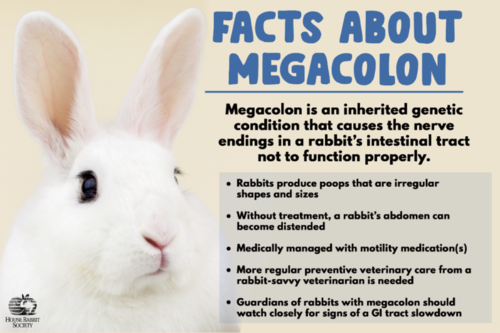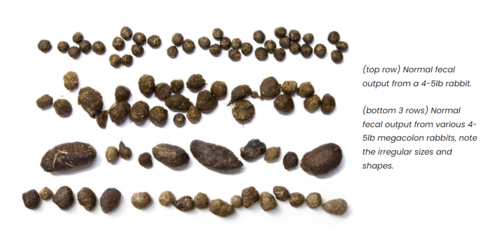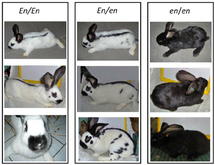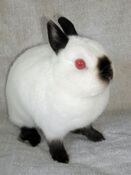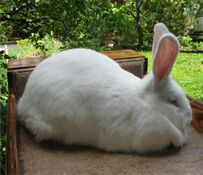Megacolon
The curse of the 33 spots...
"A change in breeders' attitude and breeding practices is mandatory because neither the permanent elimination of animals not "fitting" a fancy standard nor the continuous production of defective genotypes is legal." - Gerlitz S., Wessel G., Wieberneit D., & Wegner W.
Genetic Megacolon is caused by the KIT (v-kit Hardy-Zuckerman 4 feline sarcoma viral oncogene homolog) gene. It's sometimes referred to as Rabbit megacolon syndrome (RMS). Older terms may refer to it as congenital agangliosis or cow pile syndrome (CPS). In the rabbit world this is sometimes referred to as the "English spotting" gene.
Symptoms
Common symptoms of rabbits exhibiting megacolon include the following:
- Big misshapen soft fecal pellets, frequently covered with mucus. A graphic of normal vs. typical megacolon rabbit feces, obtained from Long Island Rabbit Rescue.
- Common bouts of GI stasis. During incidents, it may be possible to feel large masses of fecal material similar in consistency to ropes of play dough.
- Unable to produce cecotropes.
- Difficulty maintaining weight.
Megacolon often comes in episodes, characterized by flare-ups in between periods of relative improvement.
Causes
Genetic Megacolon comes into play when a rabbit inherits two of the dominant versions of the "English spotting gene" (En/En), sometimes referred as charlies.
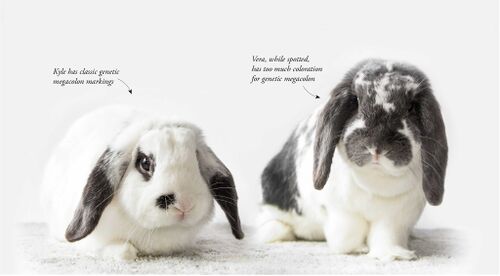
There are three options possible when inheriting the spotting genes. The latest genetic study, from the University of Bologna in Italy, shows that if a rabbit inherits a recessive and dominant (En/en - normal amount of spots) or two recessive (en/en - solid color, no spots) English spotting genes, they will not have megacolon. Only rabbits that inherit two of the dominant versions of the "English spotting gene" (En/En - very lightly spotted rabbit) can be affected by megacolon.
Rabbit colors such as ruby-eyed white (REW), blue-eyed white (BEW), and pointed white (Californian, Himalayan) can mask the inheritance of En/En due to lack of overall coloration.
During early cell migration early in the rabbit's embryonic development the KIT gene expresses itself resulting in potential problems. KIT controls some cell processes such as cell division and cell movement (migration). This includes the development of cells in the GI tract and cells called melanocytes (melanin). This results in a large reduction of cells to the rabbit's outer muscle wall in the GI tract (cecum and ascending colon). These pacemaker cells control the rate and strength that the outer muscle wall contracts that help move things along in the affected area. This is also the cause for the reduced number of spots on the rabbit's fur.
Diagnosis
At this time there is no conclusive test for the disorder. The diagnosis is presumptive in rabbits where other causes of similar symptoms are ruled out by testing or unsuccessful treatment.
Treatment
Treatment between rabbits varies greatly due to differences in digestions. Many rabbits with megacolon do not tolerate many types of greens well, but this may not be true for all. Since rabbits with megacolon often need extra nutritional support, eliminating foods may not be a good idea.
Common support tips for rabbits with megacolon include the following:
- Encourage water consumption and exercise.
- Stick to a strict feeding routine and schedule. Once you find a diet that works for your rabbit, do not change it unless it stops working.
- Keep your rabbit's area clean to reduce the number of butt baths needed.
- Minimize stress and changes.
- Keeping medications such as lactulose, metoclopramide, and cisapride on hand or as maintenance medications depending on frequency of stasis episodes.
Dr. Kanfer from the Exotic Animal Care Center recommends the following mixture twice a day for megacolon rabbits that are unable to keep on weight:[1]
- Pumpkin
- Soy protein powder (you can get at Trader Joes)
- Critical Care
- Water
A sample mixture based on Dr. Kanfer's recipe fed twice a day for a 2.3kg Mini Rex rabbit with "dry" megacolon:[2]
- 12g Science Selective Adult pellets
- 5g soy protein powder
- enough warm water to make the above a wet mash
- top with metaclopromide, cisapride, and lactulose medications
Holistic Support:
Well Kept Rabbit provides a Megacolon Support Herbal Forage and Support Tablets. They are both "a mixture of antispasmodics, anti-inflammatories, and herbs that specifically help with absorption of nutrients, countering irritation in the gut lining, and soothing mucous membranes of the GI tract."
Forage: https://wellkeptrabbit.com/products/delilahs-megacolon-tonic-37076?_pos=2&_sid=f3053775c&_ss=r
Tablets: https://wellkeptrabbit.com/products/delilahs-megacolon-tablets-08770?_pos=1&_sid=f3053775c&_ss=r
Online support communities
The following are some communities of megacolon rabbit owners:
- Facebook, Charlie Rabbits with Megacolon or Cowpile Syndrome (Private group)
- Facebook, Disabled Rabbits (Private group)
Further reading
- Nadene Stapleton. (2023). Megacolon Syndrome in Rabbits
- Long Island Rabbit Rescue. (2022). Recognizing and Managing Megacolon in Rabbits
- Dr. Sari Kanfer. Megacolon in Rabbits (Subscription required)
- Magic Happens Rabbit Rescue. (2020). Megacolon in Spotted Rabbits
- N. Stapleton. (2017). Megacolon. [PDF]
- vgr1. (2017). Megacolon - The curse of the 33 spots.
- Esther van Praag Ph.D. Megacolon in spotted/checkered rabbits (Graphic)
- Dani Tomlin. Megacolon in the Domestic Rabbit [PDF]
See also
References
- ↑ vgr1. (2017). Megacolon - The curse of the 33 spots. Retrieved 27 Feb 2023 from https://www.vgr1.com/megacolon/
- ↑ u/sneaky_dragon. (2023). Anecdotal experience with a rabbit boarding client.


